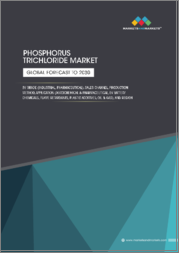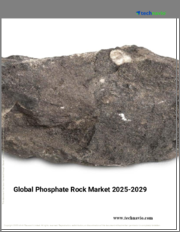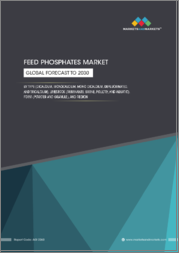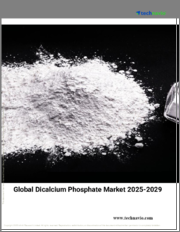
|
시장보고서
상품코드
1595334
삼염화인 시장 : 유형별, 용도별 - 세계 예측(2025-2030년)Phosphorus Trichloride Market by Type (First Grade, Sequestrants, Superior Grade), Application (Agrochemicals, Chemical Intermediate, Gasoline Additive) - Global Forecast 2025-2030 |
||||||
삼염화인 시장은 2023년에 16억 달러로 평가되었습니다. 2024년에는 16억 9,000만 달러에 이를 것으로 예측되며, CAGR 5.65%로 성장하여 2030년에는 23억 6,000만 달러에 달할 전망입니다.
삼염화인(PCl3)은 농약, 가소제, 난연제 제조의 중간체 역할을 하는 유기인 화합물 합성에 사용되는 중요한 화합물입니다. PCl3는 농업, 제약, 화학 등 다양한 산업에서 광범위하게 사용되고 있으며, 글리포세이트 제초제 생산에 있어 매우 중요한 화합물로서 농업 분야에서 그 필요성이 강조되고 있습니다. 최종 용도 범위는 화학 제조, 제약 및 농약 생산과 관련된 산업을 중심으로 합니다. 삼염화인 시장은 농업용 수요 증가와 화학 산업 확장에 힘입어 성장할 것으로 예상됩니다. 그러나 화학물질 취급에 대한 엄격한 규제 체계와 독성 및 폐기물에 대한 환경적 우려는 시장 확대를 저해하는 요인으로 작용하고 있습니다. 잠재적인 비즈니스 기회는 바이오 대체품 및 생산 효율성 향상을 위한 기술 혁신을 위한 연구 투자 증가에 있습니다. 기업이 이러한 기회를 포착하기 위해서는 지속 가능한 관행과 합성 및 다운스트림 공정의 기술 발전에 초점을 맞추는 것이 도움이 될 수 있습니다. 주요 성장 요인으로는 급성장하는 농업 부문, 제초제 수요 증가, 신흥국의 산업화 진전 등을 꼽을 수 있습니다. 유망한 성장 궤도에도 불구하고 원자재 가격 변동, 환경 규제, 노출과 관련된 건강 문제 등 심각한 장벽이 존재하기 때문에 신중한 전략적 계획이 필요합니다. 시장 경쟁은 여전히 치열하며, 주요 기업들은 환경 부하가 적은 솔루션과 효율적인 제조 기술을 개발하기 위해 연구에 투자하고 있습니다. 지속적인 사업 성장을 위해서는 환경 친화적인 제형과 안전 대책 개선을 목표로 기술 혁신을 추진해야 합니다. 새로운 연구를 위한 학술 기관과의 협력과 신흥국 시장 개척은 미개발된 잠재력을 활용할 수 있는 실행 가능한 경로를 제공합니다. 전반적으로 삼염화인 시장 특징은 도전과 동시에 역동적인 성장 기회이며, 전략적 선견지명과 지속 가능한 혁신이 산업 이해관계자들에게 중요한 역할을 할 것입니다.
| 주요 시장 통계 | |
|---|---|
| 기준 연도(2023년) | 16억 달러 |
| 예측 연도(2024년) | 16억 9,000만 달러 |
| 예측 연도(2030년) | 23억 6,000만 달러 |
| CAGR(%) | 5.65% |
시장 역학 : 빠르게 진화하는 삼염화인 시장의 주요 시장 인사이트을 공개합니다.
삼염화인 시장은 수요 및 공급의 역동적인 상호작용에 의해 변화하고 있습니다. 이러한 시장 역학의 변화를 이해함으로써 기업은 정보에 입각한 투자 결정을 내리고, 전략적 의사결정을 정교화하며, 새로운 비즈니스 기회를 포착할 수 있습니다. 이러한 트렌드를 종합적으로 파악함으로써 기업은 정치적, 지리적, 기술적, 사회적, 경제적 영역 전반에 걸친 다양한 리스크를 줄일 수 있으며, 소비자 행동과 그것이 제조 비용 및 구매 동향에 미치는 영향을 보다 명확하게 이해할 수 있습니다.
- 시장 성장 촉진요인
- 시장 성장 억제요인
- 시장 기회
- 시장 과제
- 농축 살충제 및 비료의 도입 확대
Porter's Five Forces: 삼염화인 시장 탐색을 위한 전략 도구
Porter's Five Forces 프레임워크는 시장 상황경쟁 구도를 이해하는 데 중요한 도구입니다. Porter의 Five Forces 프레임워크는 기업의 경쟁을 평가하고 전략적 기회를 모색하기 위한 명확한 방법을 설명합니다. 이 프레임워크는 기업이 시장 내 세력도를 평가하고 신규 사업의 수익성을 판단하는 데 도움이 됩니다. 이러한 통찰력을 통해 기업은 강점을 활용하고 약점을 보완하며 잠재적 도전을 피함으로써 보다 강력한 시장 포지셔닝을 확보할 수 있습니다.
PESTLE 분석 : 삼염화인 시장의 외부 영향 파악
외부 거시 환경 요인은 삼염화인 시장의 성과 역학을 형성하는 데 매우 중요한 역할을 합니다. 정치적, 경제적, 사회적, 기술적, 법적, 환경적 요인에 대한 분석은 이러한 영향을 탐색하는 데 필요한 정보를 담고 있으며, PESTLE 요인을 조사함으로써 기업은 잠재적 위험과 기회를 더 잘 이해할 수 있습니다. 이러한 분석을 통해 기업은 규제, 소비자 선호도, 경제 동향의 변화를 예측하고 선제적이고 적극적인 의사결정을 내릴 준비를 할 수 있습니다.
시장 점유율 분석 : 삼염화인 시장에서경쟁 구도 파악
삼염화인 시장의 상세한 시장 점유율 분석을 통해 공급업체의 성과를 종합적으로 평가할 수 있습니다. 기업은 수익, 고객 기반, 성장률과 같은 주요 지표를 비교하여 경쟁적 위치를 파악할 수 있습니다. 이 분석은 시장의 집중화, 세분화 및 통합 추세를 파악할 수 있으며, 이를 통해 공급업체는 치열한 경쟁에서 자신의 입지를 강화할 수 있는 전략적 의사결정을 내리는 데 필요한 통찰력을 얻을 수 있습니다.
FPNV 포지셔닝 매트릭스: 삼염화인 시장에서공급업체 성과 평가
FPNV 포지셔닝 매트릭스는 삼염화인 시장에서 공급업체를 평가할 수 있는 중요한 도구입니다. 이 매트릭스를 통해 비즈니스 조직은 벤더의 비즈니스 전략과 제품 만족도를 기반으로 평가하여 목표에 부합하는 정보에 입각한 의사결정을 내릴 수 있으며, 4개의 사분면으로 벤더를 명확하고 정확하게 세분화하여 전략 목표에 가장 적합한 파트너와 솔루션을 식별할 수 있습니다. 전략 목표에 가장 적합한 파트너와 솔루션을 식별할 수 있습니다.
전략 분석 및 추천: 삼염화인 시장에서 성공의 길을 그립니다.
삼염화인 시장 전략 분석은 세계 시장에서 입지를 강화하고자 하는 기업에게 필수적입니다. 주요 자원, 역량 및 성과 지표를 검토함으로써 기업은 성장 기회를 식별하고 개선할 수 있습니다. 이러한 접근 방식은 경쟁 환경의 도전을 극복하고 새로운 비즈니스 기회를 활용하여 장기적인 성공을 거둘 수 있는 체계를 구축할 수 있도록 도와줍니다.
이 보고서는 주요 관심 부문에 대한 종합적인 시장 분석을 제공합니다.
1. 시장 침투도 : 현재 시장 환경의 상세한 검토, 주요 기업의 광범위한 데이터, 시장 도달 범위 및 전반적인 영향력을 평가합니다.
2. 시장 개척도: 신흥 시장에서의 성장 기회를 파악하고, 기존 부문의 확장 가능성을 평가하며, 미래 성장을 위한 전략적 로드맵을 기술하고 있습니다.
3. 시장 다각화 : 최근 제품 출시, 미개척 지역, 산업의 주요 발전, 시장을 형성하는 전략적 투자를 분석합니다.
4. 경쟁 평가 및 정보 : 경쟁 구도를 철저히 분석하여 시장 점유율, 사업 전략, 제품 포트폴리오, 인증, 규제 당국의 승인, 특허 동향, 주요 기업의 기술 발전 등을 검토합니다.
5. 제품 개발 및 혁신 : 미래 시장 성장을 가속할 것으로 예상되는 첨단 기술, 연구 개발 활동 및 제품 혁신을 강조합니다.
또한, 이해관계자들이 충분한 정보를 바탕으로 의사결정을 내릴 수 있도록 중요한 질문에 대한 답변도 제공합니다.
1. 현재 시장 규모와 향후 성장 전망은?
2. 최고의 투자 기회를 제공하는 제품, 지역은?
3. 시장을 형성하는 주요 기술 동향과 규제의 영향은?
4. 주요 벤더의 시장 점유율과 경쟁 포지션은?
5.벤더 시장 진입 및 철수 전략의 원동력이 되는 수익원과 전략적 기회는 무엇인가?
목차
제1장 서문
제2장 조사 방법
제3장 주요 요약
제4장 시장 개요
제5장 시장 인사이트
- 시장 역학
- 성장 촉진요인
- 성장 억제요인
- 기회
- 과제
- 시장 세분화 분석
- Porter's Five Forces 분석
- PESTEL 분석
- 정치
- 경제
- 사회
- 기술
- 법률
- 환경
제6장 삼염화인 시장 : 유형별
- 서론
- First Grade
- Sequestrants
- Superior Grade
제7장 삼염화인 시장 : 용도별
- 서론
- 농약
- 화학 중간체
- 가솔린 첨가제
- 의약품
- 가소제
제8장 아메리카의 삼염화인 시장
- 서론
- 아르헨티나
- 브라질
- 캐나다
- 멕시코
- 미국
제9장 아시아태평양의 삼염화인 시장
- 서론
- 호주
- 중국
- 인도
- 인도네시아
- 일본
- 말레이시아
- 필리핀
- 싱가포르
- 한국
- 대만
- 태국
- 베트남
제10장 유럽, 중동 및 아프리카의 삼염화인 시장
- 서론
- 덴마크
- 이집트
- 핀란드
- 프랑스
- 독일
- 이스라엘
- 이탈리아
- 네덜란드
- 나이지리아
- 노르웨이
- 폴란드
- 카타르
- 러시아
- 사우디아라비아
- 남아프리카공화국
- 스페인
- 스웨덴
- 스위스
- 터키
- 아랍에미리트(UAE)
- 영국
제11장 경쟁 구도
- 시장 점유율 분석, 2023년
- FPNV 포지셔닝 매트릭스, 2023년
- 경쟁 시나리오 분석
- 전략 분석과 제안
기업 리스트
- Anhui Guangxin Agrochemical Co., Ltd.
- Anhui Royal Chemical Co., Ltd.
- Central Drug House(P) Ltd.
- Excel Industries Ltd.
- Futong Chemical Co., Ltd.
- Israel Chemicals Ltd.
- Italmatch Chemicals S.p.A.
- Lanxess AG
- Merck KGaA
- Oakwood Products, Inc.
- Otto Chemie Pvt. Ltd.
- PCC Rokita SA
- Sandhya Group
- Shree Maruti Impex India
- Solvay SA
- Spectrum Chemical Mfg. Corp.
- Thermo Fisher Scientific Inc.
- Tokyo Chemical Industry Co., Ltd.
- UPL Limited
- Vizag Chemicals
- Xuzhou JianPing Chemical Co., Ltd.
The Phosphorus Trichloride Market was valued at USD 1.60 billion in 2023, expected to reach USD 1.69 billion in 2024, and is projected to grow at a CAGR of 5.65%, to USD 2.36 billion by 2030.
Phosphorus trichloride (PCl3) is a crucial chemical compound utilized in the synthesis of organophosphorus compounds, serving as an intermediate in the production of agrochemicals, plasticizers, and flame retardants. Its necessity is underscored by its extensive application in various industries including agriculture, pharmaceuticals, and chemicals. PCl3 acts as a pivotal compound in the production of glyphosate herbicides, highlighting its indispensability within the agricultural sector. The end-use scope predominantly spans industries involved in chemicals manufacturing, pharmaceuticals, and agrochemical production. The market for phosphorus trichloride is poised for growth, driven by increasing demand in agricultural applications and the expanding chemical industry. However, challenges such as stringent regulatory frameworks regarding chemical handling and environmental concerns about toxicity and disposal impede market expansion. Potential opportunities lie in rising investment in research for bio-based alternatives and innovations aimed at enhancing production efficiency. For businesses to capture these opportunities, focusing on sustainable practices and technological advancements in synthesis and downstream processing can prove beneficial. Key growth influencers include the burgeoning agriculture sector, increasing demand for herbicides, and escalating industrialization in emerging economies. Despite the promising growth trajectory, significant barriers exist including fluctuating raw material prices, environmental regulations, and health concerns related to exposure, necessitating cautious strategic planning. The market remains extremely competitive, with key players investing in research to develop low-impact solutions and efficient manufacturing technologies. For sustained business growth, innovation should target environmentally-friendly formulations and improved safety measures. Collaboration with academic institutions for novel research and tapping into the growing market in developing regions offer viable pathways to harness untapped potential. Overall, the phosphorus trichloride market features dynamic growth opportunities albeit with challenges, making strategic foresight and sustainable innovation critical for industry stakeholders.
KEY MARKET STATISTICS Base Year [2023] USD 1.60 billion Estimated Year [2024] USD 1.69 billion Forecast Year [2030] USD 2.36 billion CAGR (%) 5.65% Market Dynamics: Unveiling Key Market Insights in the Rapidly Evolving Phosphorus Trichloride Market
The Phosphorus Trichloride Market is undergoing transformative changes driven by a dynamic interplay of supply and demand factors. Understanding these evolving market dynamics prepares business organizations to make informed investment decisions, refine strategic decisions, and seize new opportunities. By gaining a comprehensive view of these trends, business organizations can mitigate various risks across political, geographic, technical, social, and economic domains while also gaining a clearer understanding of consumer behavior and its impact on manufacturing costs and purchasing trends.
- Market Drivers
- Increasing demand for agrochemicals and fertilizers
- Extensive applications in textile and specialty chemicals
- Market Restraints
- Fluctuating availability and prices of raw materials
- Market Opportunities
- Rapid expansion of pharmaceutical industry across economies
- Growing investments in plasticizer production facilities
- Market Challenges
- Growing implementation on concentrated pesticides and fertilizers
Porter's Five Forces: A Strategic Tool for Navigating the Phosphorus Trichloride Market
Porter's five forces framework is a critical tool for understanding the competitive landscape of the Phosphorus Trichloride Market. It offers business organizations with a clear methodology for evaluating their competitive positioning and exploring strategic opportunities. This framework helps businesses assess the power dynamics within the market and determine the profitability of new ventures. With these insights, business organizations can leverage their strengths, address weaknesses, and avoid potential challenges, ensuring a more resilient market positioning.
PESTLE Analysis: Navigating External Influences in the Phosphorus Trichloride Market
External macro-environmental factors play a pivotal role in shaping the performance dynamics of the Phosphorus Trichloride Market. Political, Economic, Social, Technological, Legal, and Environmental factors analysis provides the necessary information to navigate these influences. By examining PESTLE factors, businesses can better understand potential risks and opportunities. This analysis enables business organizations to anticipate changes in regulations, consumer preferences, and economic trends, ensuring they are prepared to make proactive, forward-thinking decisions.
Market Share Analysis: Understanding the Competitive Landscape in the Phosphorus Trichloride Market
A detailed market share analysis in the Phosphorus Trichloride Market provides a comprehensive assessment of vendors' performance. Companies can identify their competitive positioning by comparing key metrics, including revenue, customer base, and growth rates. This analysis highlights market concentration, fragmentation, and trends in consolidation, offering vendors the insights required to make strategic decisions that enhance their position in an increasingly competitive landscape.
FPNV Positioning Matrix: Evaluating Vendors' Performance in the Phosphorus Trichloride Market
The Forefront, Pathfinder, Niche, Vital (FPNV) Positioning Matrix is a critical tool for evaluating vendors within the Phosphorus Trichloride Market. This matrix enables business organizations to make well-informed decisions that align with their goals by assessing vendors based on their business strategy and product satisfaction. The four quadrants provide a clear and precise segmentation of vendors, helping users identify the right partners and solutions that best fit their strategic objectives.
Strategy Analysis & Recommendation: Charting a Path to Success in the Phosphorus Trichloride Market
A strategic analysis of the Phosphorus Trichloride Market is essential for businesses looking to strengthen their global market presence. By reviewing key resources, capabilities, and performance indicators, business organizations can identify growth opportunities and work toward improvement. This approach helps businesses navigate challenges in the competitive landscape and ensures they are well-positioned to capitalize on newer opportunities and drive long-term success.
Key Company Profiles
The report delves into recent significant developments in the Phosphorus Trichloride Market, highlighting leading vendors and their innovative profiles. These include Anhui Guangxin Agrochemical Co., Ltd., Anhui Royal Chemical Co., Ltd., Central Drug House (P) Ltd., Excel Industries Ltd., Futong Chemical Co., Ltd., Israel Chemicals Ltd., Italmatch Chemicals S.p.A., Lanxess AG, Merck KGaA, Oakwood Products, Inc., Otto Chemie Pvt. Ltd., PCC Rokita SA, Sandhya Group, Shree Maruti Impex India, Solvay SA, Spectrum Chemical Mfg. Corp., Thermo Fisher Scientific Inc., Tokyo Chemical Industry Co., Ltd., UPL Limited, Vizag Chemicals, and Xuzhou JianPing Chemical Co., Ltd..
Market Segmentation & Coverage
This research report categorizes the Phosphorus Trichloride Market to forecast the revenues and analyze trends in each of the following sub-markets:
- Based on Type, market is studied across First Grade, Sequestrants, and Superior Grade.
- Based on Application, market is studied across Agrochemicals, Chemical Intermediate, Gasoline Additive, Pharmaceuticals, and Plasticizer.
- Based on Region, market is studied across Americas, Asia-Pacific, and Europe, Middle East & Africa. The Americas is further studied across Argentina, Brazil, Canada, Mexico, and United States. The United States is further studied across California, Florida, Illinois, New York, Ohio, Pennsylvania, and Texas. The Asia-Pacific is further studied across Australia, China, India, Indonesia, Japan, Malaysia, Philippines, Singapore, South Korea, Taiwan, Thailand, and Vietnam. The Europe, Middle East & Africa is further studied across Denmark, Egypt, Finland, France, Germany, Israel, Italy, Netherlands, Nigeria, Norway, Poland, Qatar, Russia, Saudi Arabia, South Africa, Spain, Sweden, Switzerland, Turkey, United Arab Emirates, and United Kingdom.
The report offers a comprehensive analysis of the market, covering key focus areas:
1. Market Penetration: A detailed review of the current market environment, including extensive data from top industry players, evaluating their market reach and overall influence.
2. Market Development: Identifies growth opportunities in emerging markets and assesses expansion potential in established sectors, providing a strategic roadmap for future growth.
3. Market Diversification: Analyzes recent product launches, untapped geographic regions, major industry advancements, and strategic investments reshaping the market.
4. Competitive Assessment & Intelligence: Provides a thorough analysis of the competitive landscape, examining market share, business strategies, product portfolios, certifications, regulatory approvals, patent trends, and technological advancements of key players.
5. Product Development & Innovation: Highlights cutting-edge technologies, R&D activities, and product innovations expected to drive future market growth.
The report also answers critical questions to aid stakeholders in making informed decisions:
1. What is the current market size, and what is the forecasted growth?
2. Which products, segments, and regions offer the best investment opportunities?
3. What are the key technology trends and regulatory influences shaping the market?
4. How do leading vendors rank in terms of market share and competitive positioning?
5. What revenue sources and strategic opportunities drive vendors' market entry or exit strategies?
Table of Contents
1. Preface
- 1.1. Objectives of the Study
- 1.2. Market Segmentation & Coverage
- 1.3. Years Considered for the Study
- 1.4. Currency & Pricing
- 1.5. Language
- 1.6. Stakeholders
2. Research Methodology
- 2.1. Define: Research Objective
- 2.2. Determine: Research Design
- 2.3. Prepare: Research Instrument
- 2.4. Collect: Data Source
- 2.5. Analyze: Data Interpretation
- 2.6. Formulate: Data Verification
- 2.7. Publish: Research Report
- 2.8. Repeat: Report Update
3. Executive Summary
4. Market Overview
5. Market Insights
- 5.1. Market Dynamics
- 5.1.1. Drivers
- 5.1.1.1. Increasing demand for agrochemicals and fertilizers
- 5.1.1.2. Extensive applications in textile and specialty chemicals
- 5.1.2. Restraints
- 5.1.2.1. Fluctuating availability and prices of raw materials
- 5.1.3. Opportunities
- 5.1.3.1. Rapid expansion of pharmaceutical industry across economies
- 5.1.3.2. Growing investments in plasticizer production facilities
- 5.1.4. Challenges
- 5.1.4.1. Growing implementation on concentrated pesticides and fertilizers
- 5.1.1. Drivers
- 5.2. Market Segmentation Analysis
- 5.3. Porter's Five Forces Analysis
- 5.3.1. Threat of New Entrants
- 5.3.2. Threat of Substitutes
- 5.3.3. Bargaining Power of Customers
- 5.3.4. Bargaining Power of Suppliers
- 5.3.5. Industry Rivalry
- 5.4. PESTLE Analysis
- 5.4.1. Political
- 5.4.2. Economic
- 5.4.3. Social
- 5.4.4. Technological
- 5.4.5. Legal
- 5.4.6. Environmental
6. Phosphorus Trichloride Market, by Type
- 6.1. Introduction
- 6.2. First Grade
- 6.3. Sequestrants
- 6.4. Superior Grade
7. Phosphorus Trichloride Market, by Application
- 7.1. Introduction
- 7.2. Agrochemicals
- 7.3. Chemical Intermediate
- 7.4. Gasoline Additive
- 7.5. Pharmaceuticals
- 7.6. Plasticizer
8. Americas Phosphorus Trichloride Market
- 8.1. Introduction
- 8.2. Argentina
- 8.3. Brazil
- 8.4. Canada
- 8.5. Mexico
- 8.6. United States
9. Asia-Pacific Phosphorus Trichloride Market
- 9.1. Introduction
- 9.2. Australia
- 9.3. China
- 9.4. India
- 9.5. Indonesia
- 9.6. Japan
- 9.7. Malaysia
- 9.8. Philippines
- 9.9. Singapore
- 9.10. South Korea
- 9.11. Taiwan
- 9.12. Thailand
- 9.13. Vietnam
10. Europe, Middle East & Africa Phosphorus Trichloride Market
- 10.1. Introduction
- 10.2. Denmark
- 10.3. Egypt
- 10.4. Finland
- 10.5. France
- 10.6. Germany
- 10.7. Israel
- 10.8. Italy
- 10.9. Netherlands
- 10.10. Nigeria
- 10.11. Norway
- 10.12. Poland
- 10.13. Qatar
- 10.14. Russia
- 10.15. Saudi Arabia
- 10.16. South Africa
- 10.17. Spain
- 10.18. Sweden
- 10.19. Switzerland
- 10.20. Turkey
- 10.21. United Arab Emirates
- 10.22. United Kingdom
11. Competitive Landscape
- 11.1. Market Share Analysis, 2023
- 11.2. FPNV Positioning Matrix, 2023
- 11.3. Competitive Scenario Analysis
- 11.4. Strategy Analysis & Recommendation
Companies Mentioned
- 1. Anhui Guangxin Agrochemical Co., Ltd.
- 2. Anhui Royal Chemical Co., Ltd.
- 3. Central Drug House (P) Ltd.
- 4. Excel Industries Ltd.
- 5. Futong Chemical Co., Ltd.
- 6. Israel Chemicals Ltd.
- 7. Italmatch Chemicals S.p.A.
- 8. Lanxess AG
- 9. Merck KGaA
- 10. Oakwood Products, Inc.
- 11. Otto Chemie Pvt. Ltd.
- 12. PCC Rokita SA
- 13. Sandhya Group
- 14. Shree Maruti Impex India
- 15. Solvay SA
- 16. Spectrum Chemical Mfg. Corp.
- 17. Thermo Fisher Scientific Inc.
- 18. Tokyo Chemical Industry Co., Ltd.
- 19. UPL Limited
- 20. Vizag Chemicals
- 21. Xuzhou JianPing Chemical Co., Ltd.



















